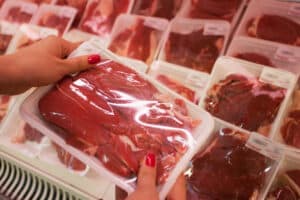Salmonella Linked To U.S., Mexican Products Blamed For Killing 2, Infecting 255

Cheese from Mexico and beef from the United States could be responsible for salmonella infecting 255 people and killing two, according to a federal agency.
A salmonella outbreak from June 2018 – March 2019 was resistant to two drugs commonly used to treat the infection, according to UPI. That drew a warning from the Centers for Disease Control and Prevention (CDC).
The CDC announced that the strain of salmonella was not responsive to azithromycin and ciprofloxacin. Those are antibiotics often used to treat salmonella infection.
The salmonella infections included 60 hospitalizations in 32 states.
What are the facts and figures regarding food-borne salmonella?
The CDC report said that the strain of salmonella could have been started by U.S.-bred beef and Mexico-manufactured soft cheese. This could mean the infection is present in both countries.
The genetic similarity between the strains of salmonella found in the two countries “strongly suggests” the strain is present in cattle in the U.S. and Mexico, the CDC said.
Salmonella bacteria typically live in animal and human intestines and are shed through feces. Humans become infected most frequently through contaminated water or food, according to the Mayo Clinic.
Feces may get onto raw meat and poultry during the butchering process. Seafood may be contaminated if harvested from contaminated water.
Salmonella symptoms include stomach cramps, diarrhea, and fever between 12-72 hours of infection. Symptoms typically occur between 8-72 hours.
The CDC estimated salmonella causes about 1.2 million illnesses, 23,000 hospitalizations and 450 deaths in the U.S. every year. Food is the source of about 1 million of these illnesses.
Salmonella infection usually isn’t life-threatening. The development of complications could be dangerous to certain groups, like infants and young children, older adults, transplant recipients, pregnant women and people with weakened immune systems.
How is salmonella linked to beef products?
El Paso, Texas is a key entry point into the U.S. from Mexico and cattle is big business in the Lone Star State. Texas is the nation’s number one producer of cattle with an estimated 13 million heads of cattle in 2019, according to the National Cattlemen’s Beef Association.
The salmonella infections were linked to beef obtained in the U.S. and soft cheese obtained in Mexico. Among patients who did not travel to Mexico, the CDC said, beef was identified as a source of infection.
The genetic similarity between samples of the beef in Mexico, beef in the U.S. and a steer in the U.S. strongly suggests that the outbreak strain is present in cattle in both countries.
The detection of the outbreak strain in cheese purchased in Mexico and the high percentage of travelers to Mexico who reported eating Mexican-style soft cheese suggest that soft cheese from Mexico was a source of infection. Mexican-style soft cheese previously has been identified as a source of other salmonella outbreaks.
Consumers should be cautious when eating beef and dairy products from Mexico. Avoid eating soft cheese that could be made from unpasteurized milk, regardless of the source of the cheese.
When preparing beef, a food thermometer should be used to ensure that appropriate cooking temperatures are reached. When antibiotic treatment is needed for a patient, clinicians should choose antibiotics based on testing, wherever possible.
Contact the Law Offices of Michael J. Gopin, PLLC in El Paso, Texas today for help with cases of food poisoning and other personal injury cases.

Michael J. Gopin has practiced law in El Paso since 1987. Even after more than 30 years, he still remembers his first jury case. He graduated from the University of Texas in Austin in 1983 with a bachelor of business administration, majoring in accounting. He received his juris doctorate degree from St. Mary’s School of Law in San Antonio. Michael has successfully handled countless cases of medical malpractice, product liability, personal injury, and nursing home negligence. He enjoys helping people “get their lives back in order” by providing high-quality legal representation and compassionate customer service.





